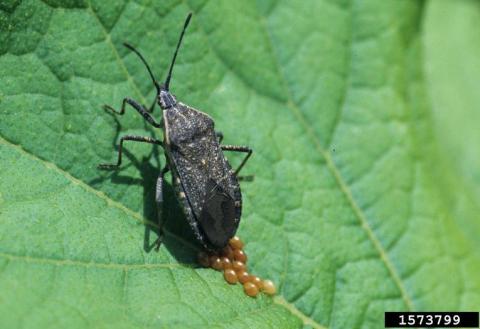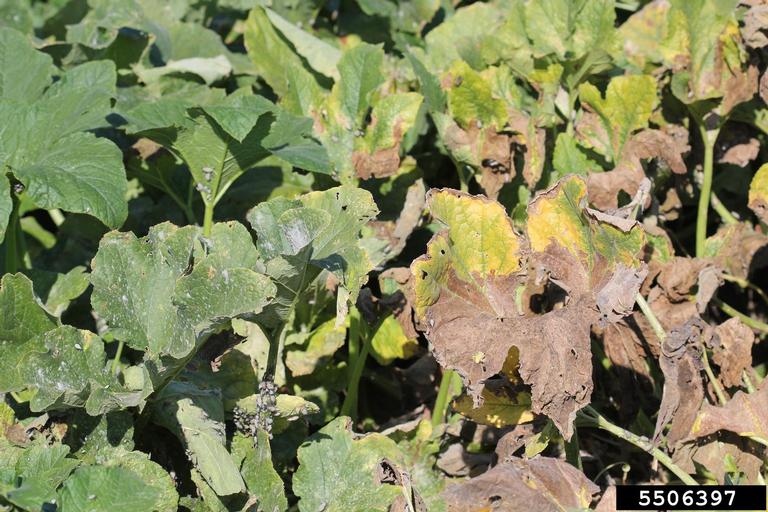What bug is eating my squash plants?

Squash bugs (Anasa tristis) are one of the most common insect pests found on squash and pumpkins in the home garden. Although they are speedy, in high numbers, adult squash bugs are hard to miss. , They are relatively large (5/8 inch long and 1/3 inch wide) and have characteristically flattened dark gray to dark brown bodies with orangish and brown bars on their abdomens. Squash bug eggs are oval and laid in clusters on the undersides of leaves, making them easier to spot. The yellowish to bronze eggs are about 1/16 inch long and are often located in the junction of major leaf veins. After 10days or so, immature squash bugs called nymphs hatch and begin going through five stages of development, known as instars, before emerging as adults. As they grow, the abdomens of the nymphs change from pale green to gray, and finally to brownish gray. Adults and nymphs are often found feeding together on squash plants as the summer progresses.
Life History and Damage
Squash bugs overwinter as adults. At the end of the growing season, with the advent of cold temperatures, they fly or crawl to protected hiding spots like garden debris, wood piles or the undersides of rocks and logs. Adults emerge when the weather warms in the spring to mate and find plants on which to feed and lay their eggs. Preferred host plants of squash bugs include pumpkins, Hubbard squash, zucchini and yellow summer squash. Other cucurbit crops such as cucumbers and melons are generally resistant to attack. Once a female squash bug has located a squash plant, usually in June, she will lay around 20 eggs. Egg-laying can continue through mid-summer, though nymphs that hatch later in the season may die once temperatures dip below freezing.

Squash bugs damage plants with their piercing/sucking mouthparts. Both adults and nymphs use their stylets to puncture and suck juices from leaves and fruit. This feeding damage on leaves produces yellow spots, eventually causing the leaves to turn brown and die. As leaf cells are destroyed, the vascular system of the squash leaf is disrupted, sometimes causing wilting that can resemble bacterial wilt. A heavy infestation early in the season may be enough to kill young plants. Squash bugs can also injure fruit by creating sunken, dead areas that rot or by causing corky scars to form on the fruit surface.

Management
Effectively managing squash bugs in the garden starts with keeping plants healthy though proper watering and fertilization, as vigorous plants are more resistant to feeding damage. Scouting for squash bugs in the garden early and often is also essential. While adults are usually too fast to catch, nymphs can be hand-picked and plopped in a bucket of soapy water. Eggs can be crushed.
An excellent non-chemical way of eliminating adults is to lay out boards in the garden near squash plants. Squash bugs will hide under the boards at night, making it easy to collect and destroy them in the early morning when temperatures are low and they are moving slowly. Removing hiding spots in the garden is also important. Avoid mulching with hay or straw, and clean up plant debris throughout the season. Clearing as much debris from the garden as possible in the fall helps reduce the number of suitable overwintering spots for adults.
Chemical intervention should only be considered early in the season when plants are young and most vulnerable to attack and when squash bug feeding is heavy. Spray in the early morning or evening when bees are less active to reduce potential impacts on pollinators. Make sure to cover the undersides of leaves where the majority of squash bugs do their feeding. Any insecticide used should list cucurbit crops and squash bugs on the label and should be applied in accordance to the directions.
Top: Gerald Holmes, California Polytechnic State University at San Luis Obispo, Bugwood.org
Got questions? The Ask UNH Extension Infoline offers practical help finding answers for your home, yard, and garden questions. Call toll free at 1-877-398-4769, Monday to Friday, 9 a.m. to 2 p.m., or e-mail us at answers@unh.edu.
Related Resource(s)
Do you love learning about stuff like this?
SUBSCRIBE TO Granite State Gardening newsletter
Got questions? The UNH Extension Yard and Garden Infoline offers practical help finding answers for your yard and garden questions.
Call toll free at 1-877-398-4769, Monday to Friday, 9 a.m. to 2 p.m., or fill out webform.
